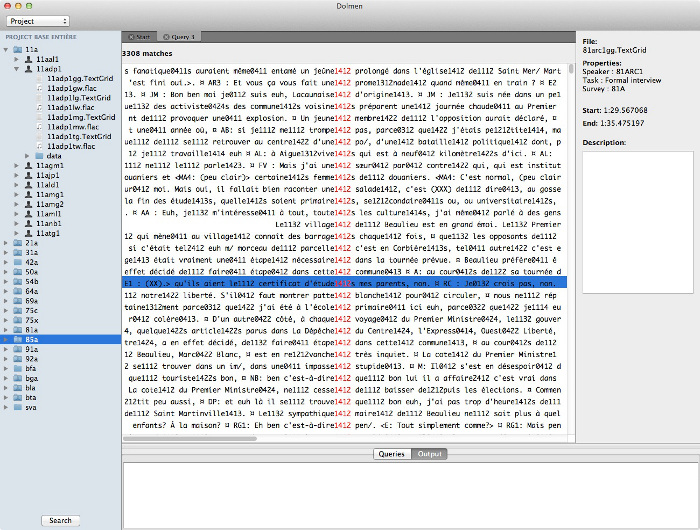Dolmen

Dolmen is now superseded by Phonometrica. Current users of Dolmen are strongly encouraged to migrate to Phonometrica.
Dolmen is now available from http://www.dolmen-ling.org. This page contains information about the legacy version of Dolmen (version 1.3).
Getting Dolmen
Download version 1.3.3 (24/5/2016):
- Windows XP and later: dolmen_setup.exe
- Mac OS X 10.7 and later: dolmen.dmg
(older version for Mac OS 10.6) - Linux (Debian 8 Jessie 64-bit): dolmen-1.3.2-linux64.tar.bz2
- source code
The documentation is available here. See the full list of changes.
Dolmen supports user plugins. Here is a simple example. To install a plugin, go to File > Install plugin… and select the zip file. It will be installed in the current user’s plugin directory.

Installation
Windows
On Windows, Dolmen is provided as a self-contained installer file. Simply double-click on ‘dolmen_setup.exe’ and follow the instructions.
The procedure will install Dolmen in your ‘Program Files’ directory and will create a shortcut in the start menu (and optionally on the desktop).
If you wish to be able to open files in Praat from Dolmen, you will need to install Praat in Dolmen’s installation directory, which should be either
C:\Program Files (x86)\Dolmen\Tools or C:\Program Files\Dolmen\Tools, depending on your system. Alternatively, you can modify Praat’s default path with
the preference editor.
Mac OS X
On Mac OS X, Dolmen is provided as a standard DMG image disk. Mount the image by double-clicking on it and drag the application Dolmen into your Applications
folder. If you wish Dolmen to be able to interact with Praat, you will need to install it in the Applications folder too.
Currently, only Mac OS X 10.6 (Snow Leopard) and later are “officially” supported. Dolmen should work for the most part on Mac OS X 10.5 (Leopard).
It does not work on earlier versions, however, for technical reasons.
On Mac OS X 10.6, if you experience any responsiveness problem, please make sure that you have installed the latest update from Apple (currently 10.6.8).
Linux
Linux (Debian/Ubuntu)
The official executable that is provided on the website is built on Ubuntu 14.04 and is available 64-bit architectures. The program is available as a dynamically-linked executable.
First make sure that the needed dependencies are installed (asound, libsndfile, speexdsp, Qt 5 and GTK 2). Most of these packages should already be installed, but you can issue the following command in a terminal to make sure they are:
sudo apt-get install libasound2 libsndfile1 libspeexdsp1 libgtk2.0-0 qt5-default libqt5sql5-sqlite libqt5script5
Next, assuming that you downloaded the archive in your Downloads directory, type the following commands in a terminal (replacing XX by the appropriate version number):
tar xvjpf dolmen-XX-linux64.tar.bz2
chmod +x dolmen/dolmen
sudo mv dolmen/dolmen /usr/local/bin
rm -r dolmen
You can now run Dolmen by simply typing dolmen from a terminal window.
If you get an error about a missing SQL plugin, try to add the following line to your .bashrc configuration file:
export LD_LIBRARY_PATH=$LD_LIBRARY_PATH:/usr/lib/x86_64-linux-gnu/qt5/plugins/sqldrivers
Compiling from source
You need to install the development packages for QT 5.3 or greater (including the script and sqlite plugins), GTK 2, ALSA (libasound2), libspeexdsp and libsndfile. You also need to manually build Qwt 6.1.0 (or later) as a static library. Then, assuming that you have downloaded the source for version 1.3 in your Downloads directory, you can compile it by typing the following commands in the terminal:
unzip dolmen-1.3.zip
cd dolmen
qmake dolmen.pro; make
this will create an executable file called dolmen that you can put anywhere. To put it in /usr/local/bin, do:
sudo mv dolmen /usr/local/bin/
Assuming that sudo is installed and properly configured on your system. Then you can run Dolmen by simply typing dolmen in the terminal.
Known issues
On Mac OS X, clicking on the sound scrollbar buttons after an item is selected in a tier results in the scollbar moving until an edge is reached.
How to cite?
If you would like to cite Dolmen, please use the following reference:
Eychenne, J. & R. Paternostro (2016, in press). “Analyzing transcribed speech with Dolmen”. In S. Detey, J. Durand, B. Laks & C. Lyche (eds) Varieties of Spoken French, Oxford: Oxford University Press, D35-D52.